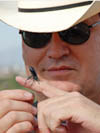August 7, 2012
 In a BBC Nature article, entomologist and sustainability scientist Quentin Wheeler talks about the possibility of a new species of swimming cave cricket recently discovered in a remote Venezuelan tepui, a type of table-top mountain.
In a BBC Nature article, entomologist and sustainability scientist Quentin Wheeler talks about the possibility of a new species of swimming cave cricket recently discovered in a remote Venezuelan tepui, a type of table-top mountain.
“Places like small islands and mountain tops and caves are really new exciting laboratories of genetic experimentation,” Wheeler says.
It was a BBC film crew that spotted the new species of cricket.
"You can't really as a biologist, put into words how it feels to see something, to film something that's never been named," says Dr. George McGavin, biologist and film presenter.
Conservation biologists call places like this hotspots - areas inhabited by a high number of endemic species that cannot be found anywhere else.
The International Institute for Species Exploration at Arizona State University collates information about newly discovered species, in part because of its value in the study of evolutionary history but also out of a concern for bio-diversity and conservation.
They record around 18,000 new species a year but Professor Wheeler said that they are not about to run out of discoveries.

